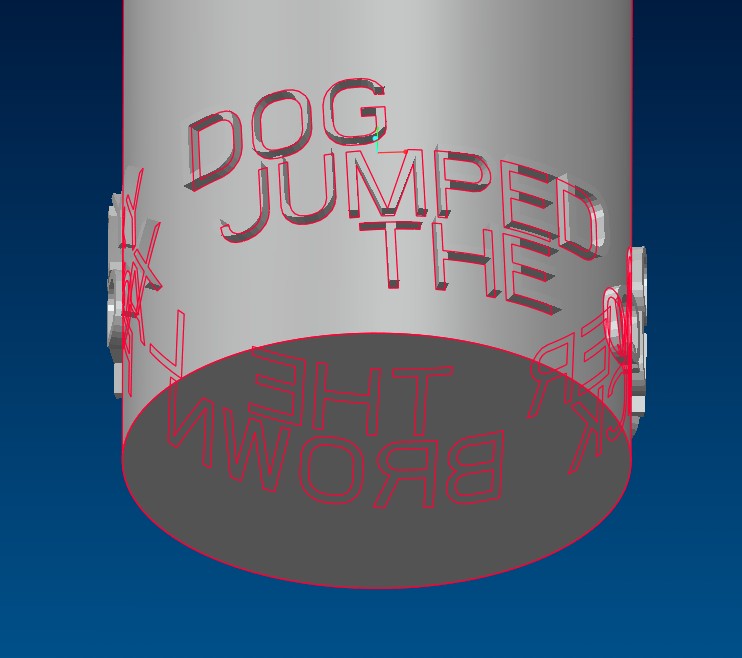Community Tip - Stay updated on what is happening on the PTC Community by subscribing to PTC Community Announcements. X
- Community
- Creo+ and Creo Parametric
- 3D Part & Assembly Design
- Re: How would you a cylinder out of text character...
- Subscribe to RSS Feed
- Mark Topic as New
- Mark Topic as Read
- Float this Topic for Current User
- Bookmark
- Subscribe
- Mute
- Printer Friendly Page
How would you a cylinder out of text characters?
- Mark as New
- Bookmark
- Subscribe
- Mute
- Subscribe to RSS Feed
- Permalink
- Notify Moderator
How would you a cylinder out of text characters?
What I want to do is make a cylinder that is actually formed from letters, so that the text is read around the cylinder like a thread, or corkscrew. The bottom of some letters will touch the top of others, and the whole cyliner will be a solid model made from text only.
I expect that the starting point would be to write in such a fashion around a cylindrical surface, then trim and thicken, but I'm having difficulty getting my head round the angles and parameters involved in order to make a start. I thought there might be someone who'd like the challenge, or maybe someone who can do this with their eyes closed.
Thanks
This thread is inactive and closed by the PTC Community Management Team. If you would like to provide a reply and re-open this thread, please notify the moderator and reference the thread. You may also use "Start a topic" button to ask a new question. Please be sure to include what version of the PTC product you are using so another community member knowledgeable about your version may be able to assist.
- Labels:
-
General
- Mark as New
- Bookmark
- Subscribe
- Mute
- Subscribe to RSS Feed
- Permalink
- Notify Moderator
I've wrapped curves onto cylinders before but you are looking at a whole lot of work in the longrun to accomplish this. You might also run into the dreaded "tangent-intersect" errors (recommending a small gap here).
If I understeand what you really want to do, you will probably have to project planer text and that would mean individual text for all the various angles. Once all the text is projected, you can cut the cylinder.
Are you after something representing a totem pole?
- Mark as New
- Bookmark
- Subscribe
- Mute
- Subscribe to RSS Feed
- Permalink
- Notify Moderator
Here is a start...
- Mark as New
- Bookmark
- Subscribe
- Mute
- Subscribe to RSS Feed
- Permalink
- Notify Moderator
I started this.... here's what I have so far.

Then, using Frank's technique...
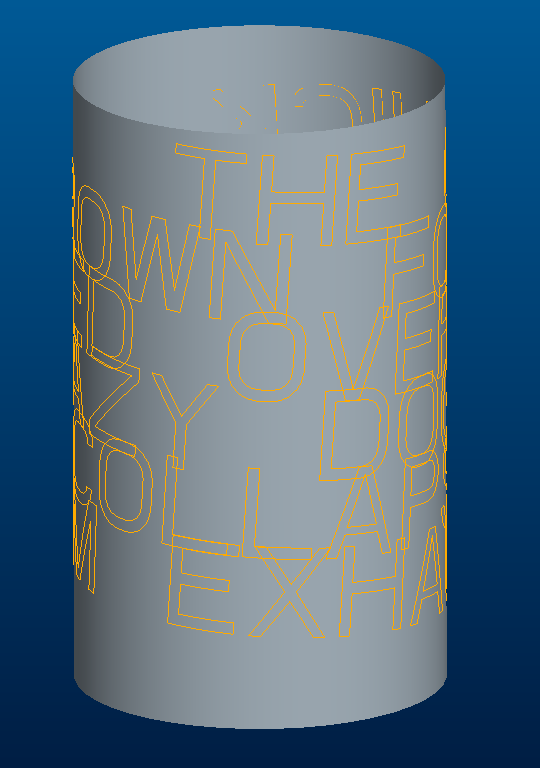
From here it gets a bit tricky. However, I was able to use a wrapped sketch to do some crazy cuts before so this starts to look possible.
Having the text from the line above anchor the lines below is a bit sketchy though. I think I could do this much nicer if I had a line between the text that could anchor the tops and bottoms of all the lines. Trying to anchor the text using tidbits of other chunks of text is possible but won't look very pretty.
Although... if you can get this to work, you could print this on a 3D printer and turn it into a nice candle holder if you put a tea light inside of it. Hmmm... maybe I just figured this out. If you write a love letter to your girlfriend in text around a cylinder... then 3D print it... you can make a nice, unique, and relatively cheap gift.
You're busted David! ![]()
Thanks!
-Brian
- Mark as New
- Bookmark
- Subscribe
- Mute
- Subscribe to RSS Feed
- Permalink
- Notify Moderator
The trick is cutting out the letters from the cylinder with the basic package. I ended up having to extrude a sketch by projecting each character, or a small group of characters and subtracting it from the cylinder. Of course, this works well, because the wrapping corrected the form of the letters. In my case, I ended up cutting out the letters, but if you have multiple surfaced to cut, then you can reverse the material removal. The beauty of this is that you can then thicken the text to get appropriate edge-angles.
Have you priced 3D printing lately? Flowers are still cheaper ![]()
The angle of the text, how it clears or intersects, can be controlled with a little reference geometry and maybe a relation or two in the original sketch. All you need is the circumference and text height to know what angle is required to get the desired effect.
One tip; in the text extrusions, if the projected sketch bysects the "edge" of the cylinder, it creates 2 line segments that are collinear, but the length of one of the lines may create errors. Deleting the two segments and replacing it with one will solve this. I could not even get Absolute Accuracy to allow this. You will see what I mean if you run into this.
tip two: before you put in too much effort, know what you're going to write and be happy with the overall initial wrap. Making changes is much like a hand written letter... you pretty much have to start over if you want it nice and clean.
- Mark as New
- Bookmark
- Subscribe
- Mute
- Subscribe to RSS Feed
- Permalink
- Notify Moderator
...also know that not all 3D text is created equal in Creo. Some just don't extrude very well or even consistently. Text is very much dependent on the Accuracy settings. The default Font3D is most stable but the ttf_font is quite inviting. Test the limitations of the characters well before committing to them.
- Mark as New
- Bookmark
- Subscribe
- Mute
- Subscribe to RSS Feed
- Permalink
- Notify Moderator
I'll take this to the next level. It's a fun thing to see just what limitations there are between surfaces and solids in Creo. Remember my reference is the base Creo parametric platform.
Remember I am using a surface cylinder so I do not need to be concerned with surface normals for the extrusions. Thickening happens later. The text used was the TTF_FONT which I knew to be troublesome due to the extensive curves. In fact, it reversed some features from the 3D_FONT I used the 1st time. Quite troublesome for "parametric" technology.
The initial cut was quite stubborn. You cannot do a solid extrude and subtract if from a surface. You have to know that you must make it a surface extrude, and you can then "remove" the material in the extrude command. The material removal direction too is critical, obviously. This action failed several times before an edit finally made it "work". It has since been stable.
The "N" did not want to extrude and posted warnings about Accuracy. Nothing I adjusted in accuracy would fix it so I ended up making a tangent plane to the cylinder pretty much centered on the "N". This finally worked.
The last bit of troubling capability was to try to remove the last remaining piece of the original cylinder. Extrude would not let me cut away the entire section. Odd! There was enough of the original cylinder with the remaining text to expect this to work. But alas, no dice.
The thicken was probably the easiest part of this. The entire surface feature was still a single feature, so it was one click, pick a side, and thickness. Done.
Last was extruding the remnant. This was a no-fuss cut now that it was solid.
I have attached the original Creo 2.0 file for your decompiling pleasure.
- Mark as New
- Bookmark
- Subscribe
- Mute
- Subscribe to RSS Feed
- Permalink
- Notify Moderator
Anybody know how to angle the letters in Creo 2.0??? I can do it in S/W, but can't figure it out in PTC.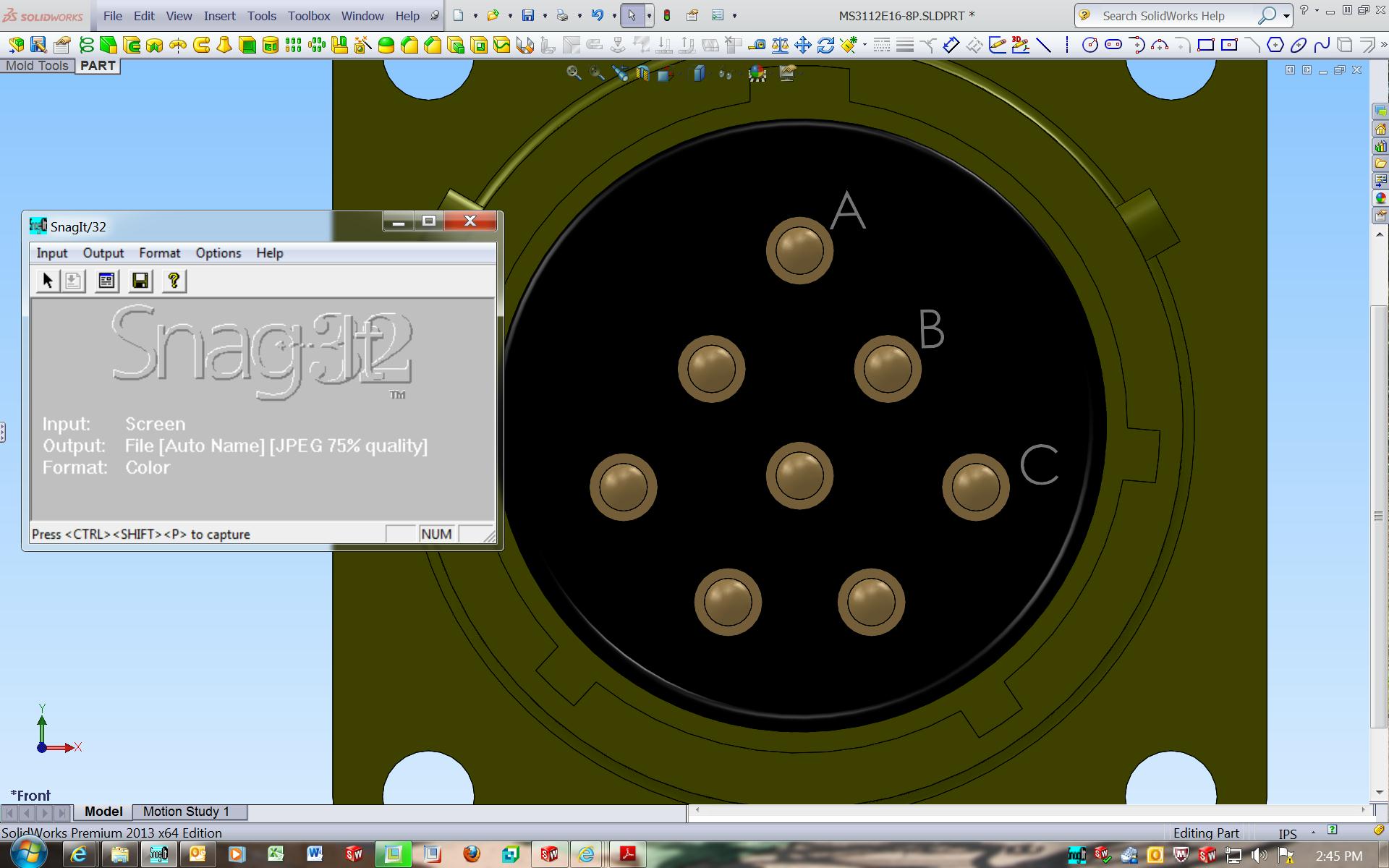
Thanks for the help.
D
- Mark as New
- Bookmark
- Subscribe
- Mute
- Subscribe to RSS Feed
- Permalink
- Notify Moderator
If you are asking about a sketched text in modeling, you can manage this easily. To create the text, you draw a line to represent the height in the sketch. You can dimension and constrain this line any way you want. Furthermore, you can also have text wrap around a curve in text. You can also use a number of fonts to do this. Here is an example of what you can do with Creo with minimal effort:
This is text extruded into a sphere. This is the same font as the original real world part.
- Mark as New
- Bookmark
- Subscribe
- Mute
- Subscribe to RSS Feed
- Permalink
- Notify Moderator
Thanks Antonius,
That wasn't really what I was after, but after some fiddling with it, it got it to do what I needed. It was alot more work than doing it in S/W, but it came out ok in Creo.
D
- Mark as New
- Bookmark
- Subscribe
- Mute
- Subscribe to RSS Feed
- Permalink
- Notify Moderator
![]() I've done text in Solidworks and it didn't seem any easier to me.
I've done text in Solidworks and it didn't seem any easier to me.
What were you really after and what method did you end up using?
- Mark as New
- Bookmark
- Subscribe
- Mute
- Subscribe to RSS Feed
- Permalink
- Notify Moderator
Well, what i wanted is ABC rotated about a line to get the font to extrude. In SW i just drew a line and rotated it to line them up. In Creo I had to draw multiple individual lines to place the text on (see pics). Any way, that portion is done.
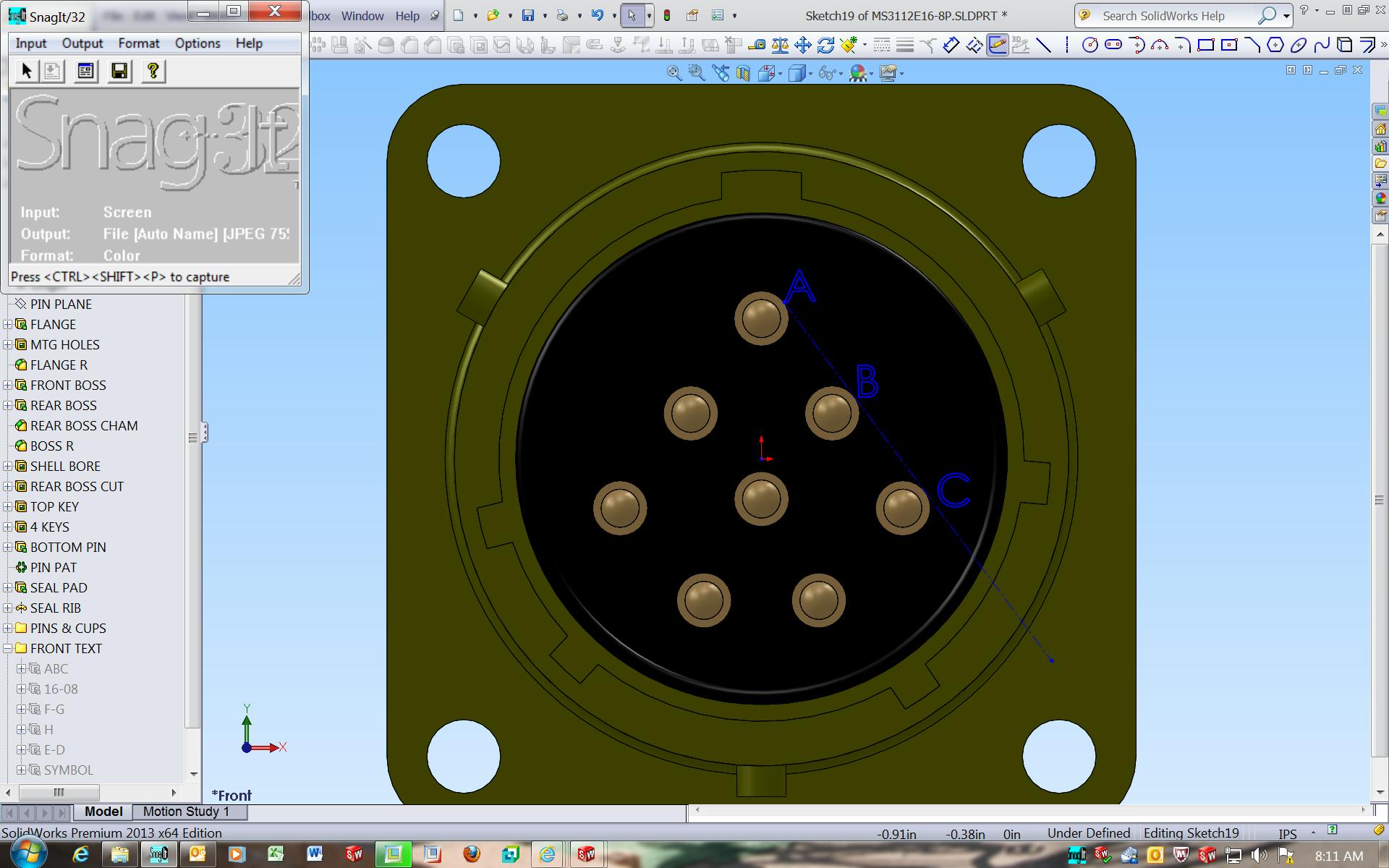

What I need now is to add the p/n. Can anyone walk me thru the torodial blend? I'm having trouble figuring out the steps. (see pics of how it was done in SW, wrap function). I did a wrap sketch in Creo, but don't know to get an extrude out of the sketch.
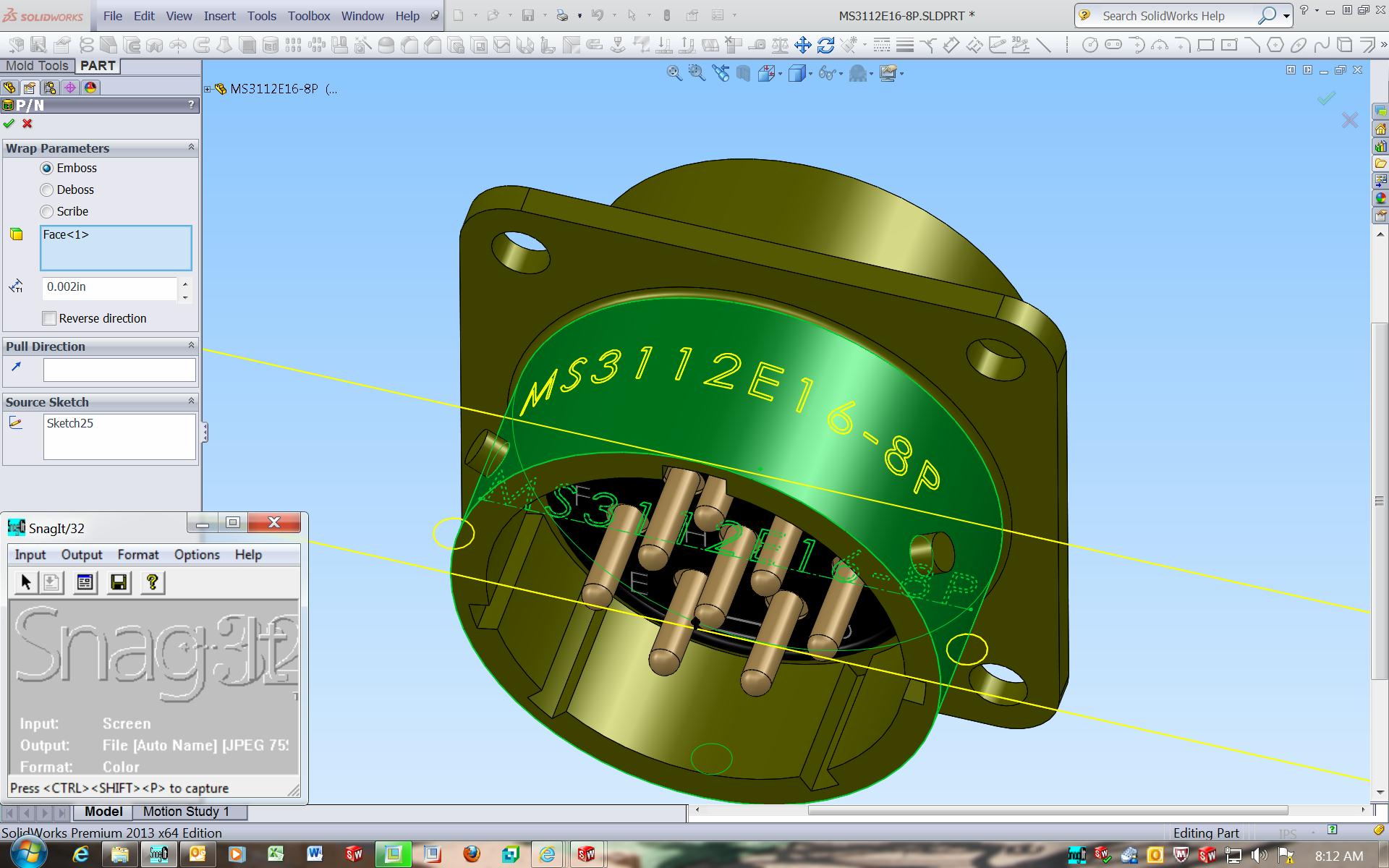

Thanks
D
- Mark as New
- Bookmark
- Subscribe
- Mute
- Subscribe to RSS Feed
- Permalink
- Notify Moderator
I suggest a special offset for the text on the cylinder. It is a little more straight forward than this discussion.
You cannot make text in offset, but you can make a sketch with text and project the curves into the projected sketch. You have to use the draft option in project to get it to map on the surface. Offset is used for anything do to with surface profiles that are not flat.
- Mark as New
- Bookmark
- Subscribe
- Mute
- Subscribe to RSS Feed
- Permalink
- Notify Moderator
David Papanek wrote:
Well, what i wanted is ABC rotated about a line to get the font to extrude. In SW i just drew a line and rotated it to line them up. In Creo I had to draw multiple individual lines to place the text on ...
In Creo, all curves are managed in sketches. You can easily manage text within a sketch the same way as you would in SW. You can format the text to control its center-point and orient it along construction geometry any way you want, even control it will all the constraints including relations and even parameters. This is, and always has been very powerful. It is simply a different way of working. And I'm not protecting PTC here, as I like a lot of features in SW, but this one is wash in my view.
But I will say, doing the same thing on anything other than planer surfaces, PTC still has a lot of work to do. It -can- be done in one of several way (as this discussion shows), but it could be a lot simpler.
- Mark as New
- Bookmark
- Subscribe
- Mute
- Subscribe to RSS Feed
- Permalink
- Notify Moderator
Hi,
did anyone consider toroidal bend? Just a thought, this is what i came up with.
John